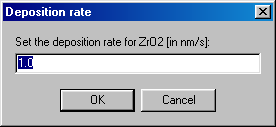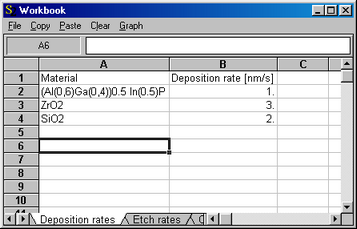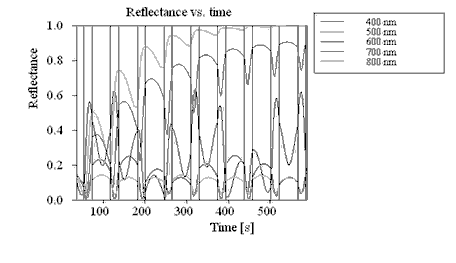Objects of type 'Opt. growth mon. (time)' (managed in the SCOUT list of distributions) compute the reflectance of a layer stack vs. time while the complete stack builds up the substrate. These objects are very similar to the previously discussed objects of type 'Optical growth monitor'.
Deposition rates
To compute charts displaying the reflectivity of a stack vs. time during the layer deposition the depositon rate for each material in the stack must be known. SCOUT stores deposition rates of materials in a text file that must be in the same directory as the program file (scout_98.exe). At program start SCOUT reads the file deposition_rates.txt and enters the data decoded there into an internal table. If you try to compute monitoring data for a material with unknown deposition rate, SCOUT will ask you to type in that missing number in a dialog like this:

As you see in the dialog, depostion rates must be specified in nm/s. SCOUT will enter the new value into its table. Materials are identified by their name in the list of dielectric functions (which is also the caption of the dielectric function window). When you shut down the SCOUT program the current table values of deposition rates are stored in the file deposition_rates.txt for future use. Usually you do not have to inspect this file at any time. However, if you want to look or modify the current values of the depositon rates you can open the SCOUT table with the menu command 'Rates'. It looks like this:

Here you can enter new values in the column labeled 'Depositon rate'. It is not recommended to enter new names in the 'Material' column because SCOUT identifies a material by its name which works reliably only in the case of perfectly correct spelling. So wait until SCOUT asks you to enter a deposition rate for a new material.
With the (fictitious) values given in the table above the reflectance vs. time curve for the deposition of the dichroic mirror example (see above) is shown below:

Note that SCOUT neglects any time for switching between the growth of the individual materials. Hence the SCOUT time for growing a stack is the minimum that you can have.